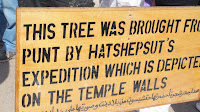From the Valley of the kings we drove to the temple of Hatshepsut, the female Pharoah.
I had carried my hat and shades to the valley of the Kings, but didnt really need it as we went to the area of the tombs by a train and everything was underground after that.
When our guide took us to Hatshepsut's temple, I forgot that this was not a tomb but temple and foolishly decided why carry such cumbersome hats etc and left it in the car.
And even though we went in November the sun drained me out.
First of all there is a vey very long walk under the open sun to the temple. And it was scorching !!
But the work is worth it. Its a beautiful temple cut out from the mountain rock. The temple is on 2 levels and the lower level has various temples dedicated to the Gods and Goddesses. The walls are inscribed with lovely paintings. Though fading we can still see the glory .
The Upper level is adorned by numerous statues of Hatshepsut in her pharonic glory.
There is a small chapel right behind with a shrine.
Hatshepsut ( /hætˈʃɛpsʊt/;[3] also Hatchepsut; meaning Foremost of Noble Ladies;1508–1458 BC) was the fifth pharaoh of the eighteenth dynasty of Ancient Egypt. She is generally regarded by Egyptologists as one of the most successful pharaohs, reigning longer than any other woman of an indigenous Egyptian dynasty
She dressed as the male pharoah and assumed all of the regalia and symbols of the pharaonic office in official representations: the Khat head cloth, topped with the uraeus, the traditional false beard, and shendyt kilt
Hatshepsut established the trade networks that had been disrupted during the Hyksos occupation of Egypt during the Second Intermediate Period, thereby building the wealth of the eighteenth dynasty.
She oversaw the preparations and funding for a mission to the Land of Punt. The expedition set out in her name with five ships, each measuring 70 feet (21 m) long bearing several sails and accommodating 210 men that included sailors and 30 rowers. Many trade goods were bought in Punt, notably myrrh.
Hatshepsut was one of the most prolific builders in ancient Egypt, commissioning hundreds of construction projects throughout both Upper Egypt and Lower Egypt, that were grander and more numerous than those of any of her Middle Kingdom predecessors. Later pharaohs attempted to claim some of her projects as theirs.
She employed the great architect Ineni, who also had worked for her father, her husband, and for the royal steward Senemut. During her reign, so much statuary was produced that almost every major museum in the world has Hatshepsut statuary among their collections; for instance, the Hatshepsut Room in New York City's Metropolitan Museum of Art is dedicated solely to some of these pieces.






No comments:
Post a Comment